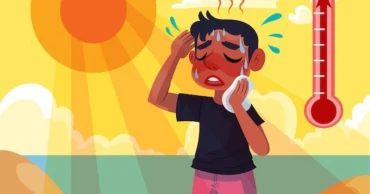Heat Exhaustion
Navigating the Risks of Summer Heat: Essential Health Tips for Pregnant Women
Summer is a time of heat and outdoor activities, but for pregnant women, it also brings the challenge of coping with intense heat waves that can pose serious health risks. From dehydration to heatstroke, the heightened vulnerability of expectant mothers requires careful strategies to ensure their health and that of their developing babies. This comprehensive guide explores practical and effective measures to safeguard pregnant women during these critical months.
Understanding the Risks for Pregnant Women in Summer
Pregnancy demands a lot from the body, which is already managing increased blood volume and the energy requirements of carrying a baby. In the summer, these challenges are compounded by higher temperatures and humidity, which can lead to faster dehydration and overheating. This increased susceptibility makes it essential to adopt preventive measures against heat-related health issues.
Hydration: The First Line of Defense Against Heat
Water is a vital ally for pregnant women during hot weather. Staying well-hydrated is crucial, as dehydration can trigger complications such as overheating, urinary tract infections, and even preterm labor. At least 8-10 glasses of water daily are recommended. Using a reusable water bottle makes it easier to stay hydrated on the go.
Read more: How to Travel Safely During Heat Waves
Electrolyte Management
Alongside hydration, maintaining electrolyte balance is critical. Loss of electrolytes through sweating can be significant in summer. Electrolyte-rich drinks or adding a pinch of salt to water can help restore balance.
Natural sources such as coconut water are also beneficial. It is important to check with a healthcare provider before incorporating new items into the diet, particularly if there are underlying health conditions.
Choosing the Right Clothing
Appropriate attire can significantly influence body temperature. Pregnant women should opt for loose, lightweight, and breathable clothing. Fabrics like cotton and linen are ideal as they allow air circulation and help prevent overheating.
Read more: Summer Tips for School-going Children
Light colors are preferable because they reflect sunlight, whereas dark colors absorb it, increasing heat retention. Comfortable, well-fitting shoes are also essential to accommodate swelling in the feet, a common issue during pregnancy.
Sun Protection Strategies
Sun protection is vital for preventing skin damage and managing body temperature. A wide-brimmed hat, UV-protective sunglasses, and sunscreen with at least SPF 30 are key to guarding against the harmful effects of UV radiation.
Limiting Exposure to Extreme Heat
It is advisable for pregnant women to minimize their time spent outdoors during peak heat hours—typically between 10 am and 4 pm. Planning activities during cooler parts of the day, such as early morning or late evening, can reduce the risk of overheating. When outside, staying in shaded areas or using an umbrella can provide immediate relief from direct sunlight.
Read more: How to Protect Outdoor Workers from Heat Stroke
1 year ago
Summer Tips for School-going Children
As the summer heatwave continues, the risk of heat exhaustion and dehydration becomes a concern. Like adults, children can suffer from severe heat-related illnesses. Therefore, parents and caregivers should be cautious, especially for school-going children who stay outside the home for hours. Here are some essential summer tips to ensure the well-being of school-going children during the hot months.
How to Keep School-going Children Healthy During Summer Heat Waves
Stay Hydrated
Ensuring children stay hydrated is crucial during a heatwave. Parents and caregivers should encourage children to drink plenty of fluids throughout the day, focusing on water as the primary source of hydration. It would be wise to avoid serving children sugary or caffeinated beverages that can contribute to dehydration.
While leaving for school, it is necessary to provide children water bottles and remind them to take regular sips, even if they are not feeling thirsty. Offer water-rich fruits and vegetables like watermelon, cucumber, and oranges as healthy snacks to help keep children hydrated.
Read more: How to Protect Outdoor Workers from Heat Stroke
Dress Appropriately
Lightweight, loose-fitting clothing of breathable fabrics like cotton or linen can help children stay cool. It is highly recommended to opt for light-coloured clothes that reflect sunlight rather than dark colours that absorb heat.
Furthermore, while staying outdoors children can wear wide-brimmed hats and sunglasses to protect their faces and eyes from the sun's harmful rays.
Seek Shade
Children might need to stay outdoors for diverse purposes, like waiting for a school bus. During such situations, children should be encouraged to seek shade or canopies to minimise direct exposure to the sun.
Read more: How to Protect Your Skin and Hair from Sun Damage
Apply Sunscreen Liberally
Sunscreen application is another crucial aspect of sun protection. Like adults, children can use broad-spectrum sunscreen with a high SPF (Sun Protection Factor) of at least 30. Before going to school or other places, kids need to apply sunscreens generously to their exposed skin, including the face, neck, arms, and legs. Nowadays many reputed brands produce child-friendly sunscreen products.
Sunscreen should be reapplied every two hours, or more frequently if children are swimming or sweating heavily. Parents and caregivers should teach children how to apply sunscreen properly and encourage them to build their sun protection routine.
Plan Outdoor Activities Wisely
While planning schedules for active outdoor games and sports during the warmer months, parents should pay attention to the matter that children stay safe from overheating or sunburn. However, when planning outdoor activities, it's essential to schedule them during the cooler parts of the day, such as early morning or late afternoon, to avoid the peak heat hours.
Read more: Summer Drinks: Refreshing Homemade Sherbets to Beat the Heat
Caregivers should guide children to play in shaded areas, such as parks with plenty of trees, or bring portable shade structures like pop-up tents or sun umbrellas to prevent sunburn and heat-related illnesses.
While playing, sweat should be wiped off immediately. Additionally, encouraging regular play breaks in shaded areas allows children to rest and hydrate. It is essential to prevent heat-related illnesses.
Stay Indoors During Peak Heat
During extreme heat, it is best to stay indoors in air-conditioned or well-ventilated spaces for children to avoid heat-related illnesses. It would be thoughtful for the parents and caregivers to plan indoor activities like board games, arts and crafts, or movie marathons to keep children entertained and safe from the heat.
Read more: Beat Dehydration with These Summer Vegetables
Educate About Heat-Related Illnesses
It is essential to teach children about the signs and symptoms of heat-related illnesses, such as heat exhaustion, heatstroke, dizziness, nausea, rapid heartbeat, etc.
Parents and caregivers should teach children to speak up if they are feeling unwell and remind them of the importance of seeking help from a trusted adult if they experience any symptoms of heat-related illness.
Use Cooling Strategies
Implementing cooling strategies like taking cool showers or baths, using fans or air conditioning, and applying cold compresses to the skin can help children beat the heat and stay comfortable indoors.
Read more: Heat Stroke Prevention: Best foods, drinks to avoid heat exhaustion
Parents and caregivers can freeze damp washcloths or water bottles and place them on pulse points like the wrists, neck, and temples to help lower the body temperature of the children. It can make their mind and body cool after returning home from school or outdoors during the heat waves.
Regular Baths
Bathing plays a vital role in maintaining cleanliness. It is important to avoid allowing children to drink or bathe in ice-cold water during hot weather. Instead, offer them water at room temperature or slightly cool.
When bathing, use water at a comfortable temperature, neither too hot nor too cold, to avoid shocking their system.
Read more: Heat Stroke: Symptoms, First Aid, and Prevention
Stay Connected
Staying connected with children, caregivers, and school staff during a heatwave is essential for assuring everyone's safety. Keep lines of communication open with children, caregivers, and school staff during summer.
Sharing information about heat safety tips and encouraging everyone to look out for each other helps create a supportive environment where everyone can stay cool, hydrated, and healthy during hot weather.
Thus, parents and caregivers can minimise the risk of heat-related illnesses in children at home, community space, school, playground, or other places.
Read more: Guidelines issued for primary schools reopening tomorrow amid heatwave
Bottom Lines
Implementing summer safety for school-going children during a heatwave is paramount to their well-being and health. Parents, caregivers, and school staff can help mitigate the risks associated with hot weather, by prioritising hydration, sun protection, appropriate clothing, and staying cool indoors during peak heat hours.
Educating children about heat-related illnesses and empowering them to recognise signs of distress is equally important. By working together and staying aware, the wellbeing and health safety of school children can be assured during the summer months.
Read more: Mist Fan Buyer Guide and Price Ranges in Bangladesh for 2024
1 year ago
Mist Fan Buyer Guide and Price Ranges in Bangladesh for 2024
Bangladesh is currently going through mild to severe heat waves. Due to the scorching sun and heat, many people are experiencing heat-related illnesses like dehydration, heat stroke, heat exhaustion, etc. Not to mention, the extremely hot weather has accelerated the sales of air conditioners. However, not everyone can afford AC due to its initial and operational costs. Nowadays, mist fans are gaining popularity as cost-effective cooling gadgets to beat the heat. It can be an affordable solution to stay cool without breaking the bank.
What’s the Difference Between a Mist Fan and an Air Conditioner?
There’s a common marketing trope that mist fans are mini air conditioners. But the truth is that mist fans and air conditioners are different things and they work on different principles.
Mist fans atomize the water and disperse in the air. The dispersed water particles quickly evaporate by absorbing the heat from the surroundings. This rapid evaporation causes a cooling effect, lowering the ambient temperature in the surrounding area.
On the other hand, air conditioners cool an area by removing the heat and humidity from the air. It uses the refrigeration principle to replace the hot air inside in a cyclic manner.
Mist fans can reduce the temperature by 3-4 degrees Celcius in a semi-open or open environment. On the other hand, air conditioners can drastically reduce the temperature as they work best in an enclosed environment.
Though mist fans are not alternatives to ACs, these cooling gadgets can give comfort by cooling the room temperature spreading mists and air.
Read more: Heat Stroke Prevention: Best foods, drinks to avoid heat exhaustion
What to Consider Before Buying a Mist Fan?
There are several things to consider while buying the perfect mist fan. With tons of options available in the market, here’s a list of things you should check before buying one.
Portability and Size
One of the key things to consider is the need for portability of your mist fan. Do you need to move it around or will it remain stationary at one place? Depending on portability, mist fans come in several sizes. It is recommended to choose one that best fits your use case.
Misting Level
The misting capacity is another thing to consider while getting a mist fan. If you plan to use the fan outdoors, it is recommended to buy a fan with a high water reserve and high misting capacity.
Mist Fan Coverage
The size and misting capacity of a mist fan greatly determines the coverage area. If you want to cover a small area, then portable type mist fans can be a great choice. When you want to cover a large area from a stationary position, consider getting a pedestal-type mist fan.
Read more: Heat Stroke: Symptoms, First Aid, and Prevention
Fan Speed and Functions
Mist fans come with different functions at different price points. A basic mist fan may provide different fan speeds but an advanced and more expensive fan may have different wind modes and mist control.
Noise Level
Large mist fans (pedestal type) make a lot of noise which can be problematic for indoor use. If you’re planning to buy a mist fan for your home, it would be wise to go for a portable or a smaller one as they tend to make less noise compared to the large pedestal ones.
Power Source
The power source is another thing to consider while buying a mist fan. For example, if you want to use the mist fan outdoors, it needs to have a battery charge feature. Many indoor mist fans also come with a dual power feature.
Rechargeability
Rechargeable mist fans can work for several hours without electricity. Depending on the specifications, these kinds of mist fans need to be connected to power lines for hours to get recharged. During power cuts and load sheddings, a charged mist fan can spread cool air and mists to keep you cool.
Read more: Summer Heatwave: Here’s How to Keep Children Safe
Durability
The durability of the fan plays an important role, especially if you are planning to use it outdoors. As a rule of thumb, sturdy, metal-built mist fans would be better for outdoor use whereas plastic ones would suffice for indoor conditions.
Additional Features
Many mist fans these days come with additional features like insect repellant, air purification, and even LED lights. You can assess each feature based on your usage.
Price and Warranty
And last but not least, it is recommended to double-check the price and warranty. Additional things to check include user reviews and brand reputation to make sure you’re getting the bang for your buck.
1 year ago
Summer Drinks: Refreshing Homemade Sherbets to Beat the Heat
The scorching heat of summer can be relentless, making it essential to find ways to stay cool and hydrated. While the allure of roadside summer drinks is undeniable, they often come with health risks due to questionable ingredients and hygiene standards. Fortunately, there is a safer and more delicious alternative – homemade sherbets. Let's explore 10 revitalising sherbet recipes to try this summer to fight heat related illnesses.
10 Homemade Sherbet Recipes to Beat Dehydration This Summer
Raw Mango Sherbet
Aam Panna, or raw mango sherbet, is a quintessential summer drink in Bangladesh for combating the sweltering heat packed with both flavour and health benefits. Made from raw mangoes, it presents a tantalising blend of tartness and sweetness. This refreshing beverage is rich in vitamins A and C, essential for maintaining hydration and boosting immunity.
To make Aam Panna, simply blend raw boiled, peeled mangoes with mint leaves, roasted cumin powder, black salt, sugar, and water until smooth. To impart a smoky nuance, consider roasting the mangoes beforehand. Serve chilled over ice for a revitalising treat that not only quenches thirst but also replenishes electrolytes and provides a burst of tropical goodness.
Read more: How to Protect Outdoor Workers from Heat Stroke
Tamarind Sherbet
Tamarind sherbet offers a tangy and refreshing escape from the scorching summer heat. Rich in vitamins and minerals, including vitamin C and potassium it offers a sweet-tart punch. It aids in replenishing electrolytes lost during sweating, thus combating dehydration.
To prepare this invigorating drink, combine tamarind pulp with water, sugar or honey, and a dash of salt. Allow the mixture to steep with a cinnamon stick, then strain and chill before serving over ice. Indulge in the zesty flavour and hydrating benefits of tamarind sherbet to stay cool and refreshed all summer long.
Rose Petal Sherbet
Rose petal sherbet embodies a fragrant and floral essence, offering a delightful respite from summer's heat. While lower in electrolytes than some options, it can provide some hydration and is a lovely source of antioxidants. Rich in antioxidants and vitamin C, it supports hydration and boosts immunity.
Read more: Beat Dehydration with These Summer Vegetables
To concoct this rejuvenating elixir, steep fresh rose petals in water, then strain and mix with sugar or honey and a splash of lemon juice. Serve chilled over ice for a cooling sensation that not only tantalises the taste buds but also replenishes vital fluids lost through perspiration. Sip on rose petal sherbet to invigorate your senses and combat dehydration effortlessly.
Bael Sherbet
Bael sherbet, a summer delight, boasts a unique flavour and impressive health benefits. Made with the pulp of the wood apple (bael), it offers a sweet-tart taste with a hint of citrus. This golden drink is a powerhouse of Vitamin C, supporting immunity and fighting inflammation. But bael truly shines in its role against dehydration.
The pulp is rich in fibre and natural electrolytes, helping your body retain fluids and recover from sweat loss. To create this revitalising drink, simply mash the pulp of a ripe bael with water, strain, and add sugar or honey to taste. A pinch of salt and a squeeze of lemon juice complete this refreshing and rehydrating summer beverage.
Read more: How to Protect Your Skin and Hair from Sun Damage
Watermelon Sherbet
Cool off with watermelon sherbet, a naturally hydrating summer treat. Made with blended watermelon, this refreshing pink drink is packed with water, making it a delicious weapon against dehydration.
Watermelon boasts vitamins A, B6, and C, as well as potassium and lycopene. It supports immunity and healthy vision. The recipe is simple: freeze seedless watermelon cubes, then blend them smooth with a touch of lime juice or honey for extra zing. Enjoy this refreshing sherbet for a hydrating and nutritious summer.
1 year ago
How to Protect Outdoor Workers from Heat Stroke
The scorching heat waves can pose serious health risks, especially for people who stay outdoors for long hours due to occupation. During hot weather situations in summer, people working under the sun may suffer from heat-related illnesses like dehydration, heatstroke, etc. Let’s explore some effective tips to safeguard outdoor workers from the debilitating effects of heat waves.
What is Heatstroke?
Heat stroke is a severe heat-related illness characterised by a body temperature of 104°F (40°C) or higher. It arises when your body overheats and the body's internal temperature regulation system fails, typically due to prolonged exposure to high temperatures or strenuous physical activity and dehydration. It is most prevalent during the summer season.
Immediate medical attention is necessary for heatstroke. If left untreated, it can swiftly lead to damage to vital organs such as the brain, heart, kidneys, and muscles. Delaying treatment exacerbates the damage, heightening the risk of severe complications or even death.
Read more: Summer Heatwave: Here’s How to Keep Children Safe
Symptoms of Heat Stroke
The most common symptoms of heatstroke include:
- High body temperature (above 104°F or 40°C)- Altered mental state, such as confusion or disorientation- Nausea and vomiting- Flushed or red skin- Rapid breathing- Rapid heartbeat.
Read more: Heat Stroke Prevention: Best foods, drinks to avoid heat exhaustion
1 year ago
Beat Dehydration with These Summer Vegetables
As the temperatures soar during the scorching summer months, it becomes increasingly crucial to prioritise hydration. Dehydration occurs when the body loses more fluids than it takes in. Dehydration may lead your body to adverse effects ranging from fatigue and headaches to more severe complications like heatstroke. While it is common knowledge to increase water intake during hot weather, many overlook the hydrating potential of the summer vegetables.
Why Incorporate Summer Veggies into Your Diet
Maintaining adequate hydration levels is crucial for maintaining overall health and well-being. Water is essential for regulating body temperature, aiding digestion, transporting nutrients, and flushing out toxins. Dehydration can lead to a range of adverse effects, including fatigue, headaches, dizziness, and even more severe complications like heatstroke.
By staying adequately hydrated, you can enhance cognitive function, improve physical performance, and support organ function. Make it a priority to drink water regularly throughout the day to ensure optimal hydration and vitality, especially in the summer heat.
Read more: How to Protect Your Skin and Hair from Sun Damage
Summer veggies are rich in diverse vitamins and nutrients. Adding vegetables to regular meals can help you stay hydrated and healthy during the warmer months. Let’s take a look into some nutritious summer veggies to fight dehydration this summer.
Nutritious Summer Vegetables to Beat Dehydration
.
Cucumber
Cucumbers are hydrating vegetables packed with nutrients like vitamins A, B, and C, along with minerals such as potassium and magnesium. With a water content over 95%, they replenish lost fluids and electrolytes, aiding hydration.
Enjoy cucumbers sliced in salads, sandwiches, or refreshing cucumber mint smoothies for a hydrating boost. Incorporating cucumbers into your diet regularly can promote skin health, aid digestion, and support overall well-being. Aim for at least one or two cups of cucumber daily to reap its hydrating benefits.
Read more: Summer Safety Tips for Elderly to Avoid Heat-related Illnesses
Tomatoes
Tomatoes are hydrating vegetables boasting a water content of around 94%. Rich in vitamins A and C, along with antioxidants like lycopene, they support immune function and promote heart health. You may incorporate tomatoes into your diet to enjoy their hydrating benefits.
Try them tossed in salads or sandwiches, blended into soups, or roasted with herbs for a flavourful side dish. It is recommended to include 1 or 2 tomatoes in your meals regularly to hydrate your body and boost your health.
Bell Peppers
Bell peppers, with a water content of approximately 92%, are hydrating vegetables rich in vitamins A, C, and K, as well as antioxidants. They support immune function, promote healthy vision, and reduce inflammation. You can incorporate bell peppers into your meals to enjoy their hydrating benefits.
Read more: 7 Comforting Soups for Upset Stomach
Add them to stir-fries, salads, or stuffed pepper recipes for a colourful and nutritious dish. Experts suggest limiting having one bell pepper in a day in your diet to stay hydrated and nourished, especially during hot weather without causing bloating or gas.
Lettuce
Lettuce varieties like iceberg and romaine are primarily composed of water. It is a hydrating vegetable that provides essential nutrients like vitamins A, K, and C, as well as folate and iron. It supports healthy skin, boosts immunity, and aids digestion.
Try to include lettuce in your diet for hydration and nutrition. Use it as a base for salads, wraps, or sandwiches for a refreshing and low-calorie meal option. Enjoy lettuce regularly to stay hydrated and promote overall well-being, aiming for around or less than two cups of green leaf lettuce per day.
Read more: 5 Mouth-watering Mango Pickle Recipes to Cherish This Summer
Spinach
Spinach, packed with water, is a hydrating vegetable loaded with vitamins A, C, and K, along with iron, potassium and folate. It supports bone health, boosts immunity, and aids in blood clotting.
Add one handful of spinach daily into your diet for hydration and nutrition. Add it to salads, smoothies, or cooked dishes for a nutritious boost. These can help you to stay hydrated and reap its numerous health benefits.
1 year ago
Summer Heatwave: Here’s How to Keep Children Safe
The summer heat can be excruciating, with soaring temperatures that are amplified by the impact of global warming. When the mercury rises, like the adults, children often suffer different health issues. Let’s find out how parents can keep their children safe from heat-related illness.
Heat-related Illness: Heatstroke vs Heat Exhaustion
Heatstroke
Heatstroke is a life-threatening condition caused by a malfunction in the body's temperature regulation system. Often it happens due to exposure to high temperatures or intense physical exertion in hot weather.
Heat Exhaustion
Heat exhaustion is a milder heat-related illness resulting from prolonged heat exposure and insufficient fluid intake. It occurs when the body becomes dehydrated and loses electrolytes through excessive sweating. Without proper treatment, it can cause heatstroke.
Read more: Class 7 student dies of heat stroke, 5 fall sick in Khulna
Causes of Heatstroke and Heat Exhaustion in Children
Immature Thermoregulatory System
Young children have a less developed ability to regulate their body temperature compared to adults. Their sweat glands may not function as efficiently, making it more challenging for them to cool down effectively in hot environments.
Increased Surface Area to Body Weight Ratio
Usually, children have larger surface areas relative to their body weight, which means they can absorb heat from the environment more quickly. This makes them more susceptible to overheating and increases the risk of heat-related illnesses.
Limited Self-awareness
Children may not recognise the signs of overheating or may not communicate their discomfort effectively. They might continue playing or engaging in physical activities despite feeling excessively hot. It increases their risk of getting ill from high heat.
Read more: Heat Stroke Prevention: Best foods, drinks to avoid heat exhaustion
Lack of Hydration Knowledge
Sometimes children are not aware of the importance of staying hydrated and forget to drink water regularly. Under the scorching summer sun, kids may continue playing, neglecting the necessity of fluid intake, which can increase their risk of dehydration.
Dependency on Adults
Children mostly rely on adults to provide them with water, shade, and appropriate clothing choices. If somehow a child is not adequately hydrated, does not take breaks, or does not take protective measures due to the negligence of the caregiver, he/she can be at a higher risk of heatstroke and heat exhaustion.
Participation in Sports or Activities
Children engaged in intense physical activities, or playing outdoors under the sun, are more at the risk of heat exhaustion. It happens especially when proper precautions are not taken. Extended periods of exertion in hot weather without adequate rest and hydration increase the risk significantly.
Read more: Heat Stroke: Symptoms, First Aid, and Prevention
Staying in Enclosed Spaces or Vehicles
Leaving children in enclosed spaces, such as a parked car under the sun, even for a short time, can be harmful for their health. Due to summer heatwaves, the temperature inside a vehicle can rise quickly, posing a severe risk of heatstroke or even death.
Lack of Adjustment
Children who have not acclimatised gradually to hot weather conditions are at higher risk of heat-related illnesses. Sudden exposure to extreme heat overwhelms their bodies. Their organs may struggle to regulate the body-temperature effectively.
Certain Medical Conditions
Children with specific medical conditions, such as asthma, obesity, diabetes, or heart disease, may have a higher risk of heat-related illnesses. These conditions can affect the body's ability to regulate temperature or increase the vulnerability to dehydration.
Read more: Summer 2023: Ceiling Fan Buyer's Guide with Price Range in Bangladesh
It is essential to be careful of these causes and take necessary precautions to protect children from excessive heat exposure. To ensure they remain adequately hydrated in hot environments is essential.
2 years ago
Heat Stroke Prevention: Best foods, drinks to avoid heat exhaustion
In recent years, summer months have become unbearable due to scorching heat. In these hot weather days, health issues like Heatstroke, dehydration, heat exhaustion, summer infections, etc are very common. However, heat stroke and heat exhaustion are not the same things. Heat exhaustion happens if your body loses extreme amounts of water and salt through sweating. On the other hand, heat stroke is a serious medical emergency that occurs when your body becomes unable to control its internal temperature. Right foods and drinks can help to avoid heat exhaustion and ultimately heat stroke.
Types of heat exhaustion
There are mainly two types of heat exhaustion conditions.
Water depletion
This kind of heat exhaustion is related to excessive thirst, weakness, headache, and even loss of consciousness.
Salt depletion
This type heat exhaustion may lead to nausea and vomiting, dizziness, and muscle cramps.
Read How to Keep Kids Well During Flu Season
Although heat exhaustion isn’t as serious as heat stroke, don’t take it lightly. Without proper care, heat exhaustion can lead to heatstroke, damage the brain and other vital organs, and even cause death.
Symptoms of Heat Exhaustion
The most common signs and symptoms of heat exhaustion are as follows:
- Confusion
- Dark-colored urine (a sign of dehydration)
- Dizziness
- Fainting
- Fatigue
- Headache
- Muscle or abdominal cramps
- Nausea, vomiting, or diarrhea
- Pale skin
- Profuse sweating
- Rapid heartbeat
Read 10 Healthy Bedtime Teas for Better Sleep, Relaxation
Best foods to avoid heat stroke in hot summer weather
Cucumber
You will get 95% water from the cucumber and it is perfect to keep your digestive system well hydrated. The skin of the cucumber is rich in vitamin C and antioxidants which helps to protect your body from damaging radicals.
Bitter gourd (karela)
Although many people don’t like bitter gourd, it is an excellent vegetable to take away the heat from your body. You will get the best result if you can take it two or three times a week. Try to intake a tablespoon of karela juice in your diet every day.
Bottle gourd
The bottle gourd carries 96% water. It is naturally cooling and rich with potassium which helps keep the blood pressure down and electrolyte balance maintained. Moreover, it helps to prevent fatigue and keeps the body cool and refreshed during summers.
Read Quit Smoking: Best, worst kinds of foods, drinks to quit cigarettes
Watermelon
Watermelon is a fat-free sweet. This juicy fruit is enriched with some of the most important antioxidants in nature which provides vitamin C, beta-carotene, vitamins B, magnesium, potassium, and many other nutrients. Vitamins B is helpful to produce necessary energy.
Barley
You can take barley as flour, pearls, and barley water during the summer season to flush out toxins from the intestine. Besides, it barely keeps your body cool during the summers. It is easy to take barley water; just boil barley for 20-25 minutes, strain the water, cool it, squeeze a lemon in it and drink it up.
Pineapple
Pineapple is loaded with water, nutrients, and antioxidants that have restorative and free radical fighting properties. Moreover, it has the perfect enzyme namely bromelain that is great to reduce body inflammation in summer.
Read Healthy Salad Ideas with Recipes to Try at Home
Cooling spices
You can take fresh ginger, marjoram, cilantro, lemon balm, peppermint, and white peppercorn during summer as they are cooling. But don’t take cinnamon and dry ginger because they are warming.
Pomegranate
Pomegranate is loaded with water and a special antioxidant namely Punicalagins. This antioxidant helps destroy toxins in the body and build metabolism and protect you against heat stroke.
Mint
Fresh mint leaves contain menthol and so they are good in summer. Menthol revives the specialized nerve endings that allow you to feel cold and an electrical impulse travels to the brain and makes you believe that it is colder outside, which automatically cools down the body mechanism.
Read Easy Homemade Drinks to Boost Up Digestion Power Naturally
Kiwi
Research shows that if you consume kiwi regularly, it helps to increase hydration levels. Kiwi is rich in potassium and sodium which help improve electrolyte levels and hence help prevent heat stroke.
Celery
Celery is 96% water and packed with sodium, potassium, magnesium, calcium, phosphorus, iron, and zinc. These vital nutrients are necessary to maintain the electrolyte balance. Besides, it protects you from heat stroke.
Snow Peas
Snow peas have hydrating effects and are also rich in vitamin C to protect the skin from sunburn, also aid in the production of collagen.
Read Healthy, Delicious Mango Recipes to Try this Summer
Pears
Pears are also hydrating fruit and rich in soluble fiber that keeps the digestive system healthy and protects you from heat stroke.
Mango
Mango is enriched with health-benefited nutrients such as proteins, Vitamins A, B6, C, iron, folate, magnesium, riboflavin, and dietary fibers. It is a superfood that has more than 20 different vitamins and minerals. From 3/4 cup of mango, you will get 50% of your daily vitamin C, 8% of your daily Vitamin A, and 8% of your daily vitamin B6.
Tomatoes
Tomatoes are a rich source of the antioxidants lycopene, vitamin C, and vitamin A. Add this to your salads as a cooling meal.
Read Upset Stomach Remedies: What to eat, drink and avoid
Salmon
You will get omega-3 fatty acids from salmon which assist your hypothalamus; a part of the brain responsible for controlling body temperature, hunger, and thirst.
Best drinks to prevent heat stroke in hot summer weather
Clean Water
If you want to hydrate yourself during summer, you need to drink enough water.
Fresh coconut water
Don’t miss this natural drink in the summers. It hydrates your body as well as is loaded with necessary minerals to maintain your body’s electrolyte balance.
Read Easy Homemade Summer Drinks to Beat the Heat and Increase Immunity
Wood Apple Juice
People take wood apples as a remedy for dysentery and other digestion-related issues for years that occur due to the hot weather. Besides, it is a great source of dietary fibers, which work as a natural laxative and help in improving digestion and relieving constipation. Take wood apple juice regularly.
Basil Seeds
Basil seeds have a unique cooling effect on the body and hence, are recommended especially for post-exercise and humid temperatures.
The worst food, drinks that increase risk of heat stroke
Don’t take beverages like alcohol and caffeinated energy drinks that can dehydrate the body during summer. These foods can increase the risk of heat stroke in the hot summer season. Heat illness is mostly related to drinking alcohol. Drinking caffeinated energy can affect your heart. Avoid spicy foods also.
Read Is Gym Good for Women?
3 years ago
Heat Stroke: Symptoms, First Aid, and Prevention
Each year the heat of the sun is increasing significantly, resulting in a variety of physical problems. One of them is heatstroke. When the body temperature is higher than 105-degree Fahrenheit, it is called heat stroke. It is a serious physical condition that can lead to death. But with a little caution this summer, we can avoid such deadly conditions.
Heat Exhaustion vs. Heat Stroke
When the external environment temperature rises, our body automatically tries to maintain the internal temperature. As the body temperature rises, the veins in the skin widen and dispel excess heat into the external environment. In addition, the body is cooled due to sweating. However, excessive sweating in extreme heat makes the body lose water and salt.
As a result, physical weakness, fatigue, dizziness, muscle aches, extreme thirst, and nausea can occur. This condition is called 'heat cramp' or 'heat exhaustion. If you stay in a humid and hot environment for a long time or if you work hard, it is not possible for the body to control the heat. Rises to 105 degrees Fahrenheit. This is called 'heatstroke.'
Read How to heal lungs naturally and improve breathing after recovering from COVID-19?
Symptoms of Heat Stroke
To deal with the heatstroke, we need to know the symptoms first so that we can take further steps. When the temperature rises in our body, various reactions occur. Initially, there may be less severe heat exhaustion or heat cramps before the heatstroke. Usually, heat cramps lead to pain in the muscles of body parts; as a result, the body feels weak and gets very thirsty.
The next stage of heat exhaustion is rapid breathing, headache, dizziness, nausea, incoherent behavior, etc. In both cases, the body heat remains under control, and the body sweats abundantly. Heatstroke can occur if immediate action is not taken in this condition.
Read How to Eat Red Meat Without Jeopardizing Your Health
Let's know the symptoms.
· The body starts sweating profusely, and suddenly the sweating stops.
· Body temperature quickly exceeds 105 degrees Fahrenheit.
· Breathing becomes fast.
· Abnormal pulse rate. For example, sudden increase and decrease of the pulse.
· Blood pressure becomes low.
· The amount of urine decreases.
· Hands and feet tremble body cramps.
· Dizziness
· Severe headache
· Sudden abnormal behavior.
· Being incoherent in speech.
Read: Clive Wearing: The Man with the 30 Second Memory - Forever Today
First Aid
If you see someone with the above-mentioned symptoms, you should come forward with first aid. As soon as symptoms of heatstroke appear, first, wipe the body with cold ice water to reduce body heat. Also, bring the infected person to a cool environment.
Taking off or loosening the body clothes as much as possible will help to reduce the body heat and pass the air. Drink plenty of cold water, fruit juice, or saline. However, if the patient loses consciousness due to heatstroke, the person should be taken to the nearest hospital as soon as possible.
Read: Beat the Heat: How to Stay Cool in Simmering Hot Weather?
Who has a Higher Risk of Heat Stroke?
Heatstroke can happen to any person in extreme heat and humid environments. However, those who work hard in the open field in the hot sun, such as farmers, workers, rickshaw pullers, are more likely to have a heat stroke. If pedestrians walk for a long time under the hot scorching sun, they can have heat stroke. Also, school children playing on the school field under the sun can also have heat stroke.
Whoever works long hours in humid and hot environments (such as garment workers) indoors or inside the factory also has risks. Elderly and children contain lower body heat capacity. Hence they are more at risk. Further, dehydration increases the risk of heatstroke. Some medications increase the risk of heatstroke, especially medicines to increase the urine, antidepressants, and psychiatric medications. In addition, older people often suffer from various diseases or take various medications, which increase the risk of heatstroke.
Read: Dengue vs. COVID-19: Symptoms, when & where to test, ways of prevention
Preventing the Heat Stroke
Heatstroke can be avoided by following some precautions on hot days. These are-
· Try to wear loose and light clothing. Moreover, the fabrics should be white or light in color. Wearing cotton clothing is better.
· Stay in a shady place or indoor as much as possible.
· When going outside, using a wide-brimmed hat, cap or umbrella can save you from excessive temperature.
· Those who are involved in work outside should cover their head with an umbrella or something.
· Drinking plenty of water and other fluids will keep the balance of salt and water in your body as both salt and water comes out with sweat.
· Should refrain from consuming tea and coffee as these can increase the temperature.
· Try to avoid working under the sun in hot weather. Try to do these tasks early in the morning or at night. However, if you are bound to do the task during the day, make sure you drink plenty of water and saline. Moreover, take a break during work and take a rest from time to time.
Read Sweet Danger of Sugar: know the side effects of consuming too much sugar
Ways to Stay Dehydrated
To stay safe from heat stroke, we should take foods that can keep our body dehydrated for a long time. You can try the following items.
Tamarind juice
Tamarind juice is very useful to cool the body quickly. Tamarind juice made with a combination of sugar and salt makes it more delicious and protects the body from dehydration quickly. It also contains potassium and magnesium, which help to keep the body healthy and functioning for a long time.
Coconut Water
There are no natural ingredients like coconut water to survive heat stroke. It instantly cools the body and maintains body heat balance. It also protects the body from dehydration, even in excessive heat. Prevents thirst for a long time and contains other mineral salts which are beneficial for our body.
Read Easy Homemade Summer Drinks to Beat the Heat and Increase Immunity
Sugarcane Juice
Sugarcane juice is very useful for dehydration, and it instantly maintains water balance in the body. Besides, it is also rich in nutrients and delicious to drink.
Lemonade/ Lemon Juice
Lemons contain vitamin C, which helps the body to refresh quickly. It is also a very tasty and healthy drink that normalizes body temperature. Mixing coriander and mint with it to make lemon juice is also beneficial for the body.
Read Easy Homemade Drinks to Boost Up Digestion Power Naturally
4 years ago















